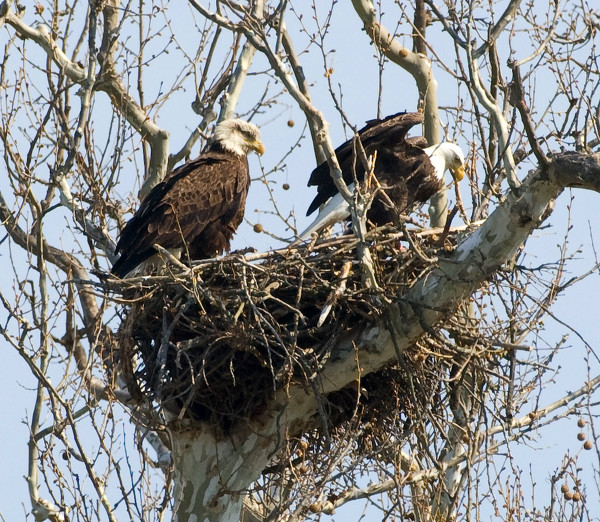Friday, April 1st, 2022
All eyes are on area nests for eagles
By Leslie Gartrell

Submitted Photo
An estimated 806 bald eagle nests were documented in Ohio in 2021, according to the most recent bald eagle census from the Ohio Department of Natural Resources Division of Wildlife. It's an estimated 14% increase from 2020, when 707 bald eagle nests were documented in the state.
Bald eagles continue to flourish in the area with at least 14 eagle nests confirmed in Mercer and Auglaize counties.
Jill Bowers, who has monitored local bald eagles since 1996, including a lengthy volunteer stint with the Ohio Division of Wildlife, said she knows Mercer County is home to as many as 10 nests.
Of those, at least six have eggs, Bowers noted. The nests are located in different areas on the west side of Grand Lake, she said.
In Auglaize County, Bowers said there are at least four nests but he believes there are probably more. All four have eggs.
However, Bowers said one nest's eggs likely have failed. A lone, injured eagle is watching over the nest so the eggs likely will not hatch, she said. The nest is located near the cemetery in St. Marys, she said.
One of the nests in Auglaize County is located near St. Marys River Road and another near Wapakoneta, Bowers said. The fourth nest is not viewable to the public, she said.
None of the eggs in either county have hatched yet to Bower's knowledge. Female bald eagles lay one to three eggs in mid-February to late March. The eggs incubate for 35 days and usually leave the nest after 10-13 weeks, according to the Ohio Department of Natural Resources Division of Wildlife.

File Photo/The Daily Standard
A bald eagle flies back to its nest along U.S. 127 near Grand Lake south of Celina in spring of 2021. Numerous eagles are nesting around the lake and throughout Mercer and Auglaize counties.
The numbers reflect a growing bald eagle population, which swelled to 806 nests in Ohio in 2021, according to an ODNR news release.
It's an estimated 14% increase from the 707 bald eagle nests documented in the state in 2020, per the release. The numbers reflect their continued recovery, Bowers said.
"Back in 1979, there were only four (breeding pairs) in Ohio, all near Lake Erie," she said. "The first nest in Mercer County was the farthest south of Lake Erie and was found in 1995. It had eggs, but they failed. Another nest successfully had eggs in 1996, and it's grown ever since."
Habitat destruction and degradation, illegal shooting and contaminated food sources, largely as a consequence of DDT, decimated the eagle population by the 1970s, according to the U.S. Fish and Wildlife Service.
Eagle eggs were affected by increased pesticide use during the 1950s and 1960s, according to Ohio History Central. The eggs did not hatch because they were either infertile or their shells were so thin the weight of the adult would crush them. No young birds were surviving to replace the dying adults.
Bald eagles were officially declared an endangered species in 1967 throughout the United States. They then were listed as endangered throughout the continental U.S. in 1978 by the U.S. Fish and Wildlife Service.

File Photo/The Daily Standard
An American bald eagle perches in a tree along the walking path in West Bank Park in 2021 in Celina.
Now, thanks to conservation efforts, the eagle population has soared and in 2007 was removed from the federal list of threatened and endangered species. The national symbol was removed from Ohio's endangered listing in 2012.
The bird of prey's ideal place to call home is close to open waterways where they can stretch their seven-and-a-half foot wingspan and feast on fish, according to the ODNR news release. They also, however, look for sites that are somewhat secluded.
This is particularly important when the nest is being established and the eaglets are raised, according to ODNR. Bald eagles are highly territorial, and too much interference from other eagles can cause problems at the nest site.
In fact, the growth of bald eagles in Ohio has become so prolific that some have trouble finding a nest, Bowers said.
"With over 800 nests in Ohio, that's a lot," she said. "With that growth, it's hard for bald eagles to find a nest. They're very territorial."
Bald eagle nesting success was at an estimated rate of 82% in the spring of 2021, according to the ODNR release. The number of young per nest was 1.6, well above the number of 1 per nest needed to sustain the population. These productivity rates are similar to previous years.
The Division of Wildlife's bald eagle nesting survey consisted of flying five blocks, each roughly 10 square miles, to search for eagle nests in woodlots and along rivers, according to the ODNR release.
Two of the blocks, one near Sandusky on Lake Erie and the other over Mosquito Creek Wildlife Area in northeast Ohio, are flown every year. The other three blocks are rotated every year.
The 2021 blocks were located around Killbuck Wildlife Area, Grand Lake, and the Maumee River in Defiance and Henry counties, according to the release.





